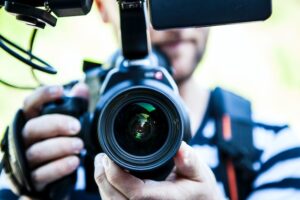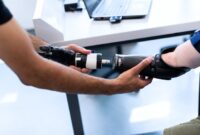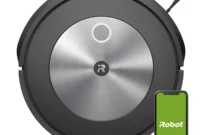Lights, camera, action! The world of filmmaking has seen tremendous advancements in technology over the years. From traditional film cameras to digital cinematography, filmmakers have always embraced innovation to bring their creative visions to life. One of the most revolutionary additions to the filmmaker’s toolkit is the drone. In this guide, we will explore the role of drones in filmmaking, the techniques they enable, the challenges they present, and the endless creative possibilities they offer.

Introduction
Filmmaking has undergone a remarkable transformation with the introduction of drones. These unmanned aerial vehicles have opened up a whole new world of possibilities for capturing stunning aerial shots and dynamic perspectives. Gone are the days when filmmakers had to rely on helicopters or cranes to achieve aerial footage. Drones have not only made aerial cinematography more accessible but also provided filmmakers with the freedom to explore unique angles and tell their stories in unprecedented ways.
The Evolution of Filmmaking Technology
Before we dive into the realm of drone filmmaking, let’s take a moment to appreciate the evolution of filmmaking technology. From the invention of the motion picture camera in the late 19th century to the rise of digital cameras in the 21st century, each technological advancement has played a pivotal role in shaping the art of filmmaking. Today, filmmakers have access to high-resolution cameras, advanced stabilization systems, and powerful editing software, all of which contribute to the creation of visually captivating films.
Rise of Drones in Filmmaking
In recent years, drones have gained immense popularity among filmmakers worldwide. These small, agile aircraft equipped with high-quality cameras have become an indispensable tool for capturing breathtaking aerial shots. Let’s explore the benefits of using drones in filmmaking and the different types of drones available.
Benefits of Using Drones
Drones offer several advantages that make them a preferred choice for filmmakers. Firstly, they provide access to aerial perspectives that were once reserved for big-budget productions. With drones, filmmakers can capture expansive establishing shots, showcase breathtaking landscapes, and create a sense of scale that adds depth to their storytelling. Secondly, drones enable dynamic tracking shots and chasing scenes, allowing filmmakers to follow subjects smoothly and effortlessly. This capability adds a thrilling element to action sequences and creates an immersive viewing experience for the audience.
Types of Drones for Filmmaking
When it comes to drones for filmmaking, there are various options available to suit different needs and budgets. Professional-grade drones like the DJI Inspire 2 and the Freefly Alta X offer exceptional image quality, advanced flight capabilities, and extensive camera control. These drones are typically used in large-scale productions and provide filmmakers with unparalleled versatility. On the other hand, compact drones like the DJI Mavic series and the Autel Evo II are popular choices for independent filmmakers and enthusiasts. These drones strike a balance between portability and performance, offering high-quality footage in a compact form factor.
Aerial Cinematography Techniques
Now that we understand the significance of drones in filmmaking let’s explore some of the aerial cinematography techniques that filmmakers can employ to elevate their visuals and storytelling.
Capturing Breathtaking Establishing Shots
One of the most impactful uses of drones in filmmaking is capturing awe-inspiring establishing shots. By flying the drone high above the location, filmmakers can set the scene and establish the context of the narrative. Whether it’s a sprawling cityscape, a serene countryside, or a majestic mountain range, drones provide filmmakers with the ability to capture the grandeur of the environment and immerse the audience from the very beginning.
Dynamic Tracking Shots and Chasing Scenes
Drones excel in capturing dynamic tracking shots and chasing scenes. With their nimble maneuverability and precise control, filmmakers can follow subjects seamlessly, creating visually captivating sequences. Imagine a high-speed car chase or an adrenaline-pumping pursuit through a dense forest. Drones allow filmmakers to capture these moments with fluidity and precision, adding a layer of excitement and intensity to the narrative.
Revealing Top-Down Perspectives
Drones offer a unique vantage point that traditional filmmaking techniques cannot replicate. By flying the drone directly overhead, filmmakers can reveal top-down perspectives that provide a fresh and intriguing view of the surroundings. This technique is particularly useful when showcasing intricate set designs, capturing the hustle and bustle of a crowd, or highlighting patterns and symmetry in architecture. The top-down perspective adds a new dimension to the visual composition, offering the audience a fresh and captivating viewing experience.
Overcoming Challenges in Drone Filmmaking
While drones provide filmmakers with unprecedented creative opportunities, there are certain challenges that need to be addressed when incorporating them into film productions. Let’s explore some of these challenges and how they can be overcome.
Legal and Regulatory Considerations
Filmmakers need to be aware of the legal and regulatory considerations associated with drone usage. Different countries have specific regulations regarding the operation of drones, especially for commercial purposes. It’s crucial to obtain the necessary permits, licenses, and certifications to ensure compliance with local laws. Additionally, filmmakers should be mindful of airspace restrictions, no-fly zones, and privacy concerns when planning their drone shots. By adhering to the applicable regulations and obtaining the required permissions, filmmakers can safely and legally incorporate drones into their productions.
Weather Conditions and Safety Precautions
Weather conditions play a significant role in drone operations. Strong winds, rain, or extreme temperatures can impact the performance and stability of the drone, potentially compromising the safety of the crew and equipment. It’s essential for filmmakers to monitor weather forecasts and assess the suitability of flying conditions before conducting drone shoots. Safety should always be the top priority, and precautions such as maintaining a safe distance from people and property, performing pre-flight checks, and having a backup plan in case of emergencies should be taken into consideration.
Battery Life and Equipment Limitations
Drone flights are limited by the battery life of the aircraft. Filmmakers must carefully plan their shots and manage their flight time to ensure they capture the desired footage without running out of power. It’s advisable to carry spare batteries and charging equipment to extend the shooting duration. Additionally, drones have payload limitations, including camera weight and accessory compatibility. Filmmakers need to choose the appropriate drone model and accessories that meet their specific requirements and ensure smooth and stable flight operations.
Enhancing Filmmaking Creativity with Drones
Drones not only provide filmmakers with technical advantages but also open up new creative possibilities. Let’s explore how drones can enhance filmmaking creativity and storytelling.
Unconventional Angles and Perspectives
Drones enable filmmakers to explore unconventional angles and perspectives that were previously inaccessible or prohibitively expensive. By flying close to the ground or weaving through tight spaces, drones can capture unique and immersive shots that engage the audience in unexpected ways. Whether it’s a low-level tracking shot through a dense forest or a close-up shot of a character’s face from a bird’s-eye view, these unconventional angles add a fresh and captivating element to the storytelling.
Seamless Transitions and Visual Storytelling
Drones provide filmmakers with the ability to create seamless transitions between scenes and locations. By smoothly transitioning from an aerial shot to a ground-level shot or vice versa, filmmakers can establish visual continuity and maintain the flow of the narrative. These transitions not only enhance the visual appeal but also contribute to the storytelling process. By juxtaposing different perspectives and seamlessly blending them together, filmmakers can create a visually stunning and cohesive narrative.
Incorporating Special Effects and CGI
Drones can be utilized in combination with special effects and computer-generated imagery (CGI) to create breathtaking visuals. By integrating drone footage with CGI elements, filmmakers can transport the audience into fantastical worlds, create stunning visual effects, and push the boundaries of imagination. Whether it’s adding mythical creatures, virtual landscapes, or futuristic cityscapes, the combination of drones and CGI opens up endless possibilities for filmmakers to create visually stunning and immersive cinematic experiences.
Tools and Accessories for Drone Filmmaking
To achieve professional-quality results in drone filmmaking, filmmakers need to equip themselves with the right tools and accessories. Let’s explore some essential equipment that enhances the filmmaking process.
Camera Mounts and Gimbals
Camera mounts and gimbals are crucial for achieving stable and smooth footage while operating a drone. These devices help counteract the vibrations and movements of the drone, ensuring that the camera remains steady and produces high-quality footage. Popular camera mounts and gimbals include the DJI Zenmuse series and the Freefly MoVI series. These devices provide filmmakers with precise control over the camera’s movement, allowing for smooth panning, tilting, and tracking shots.
Drone Tracking Systems and Controllers
To achieve complex tracking shots and precise control over the drone’s movement, filmmakers can use drone tracking systems and specialized controllers. These systems enable the drone to follow a subject automatically while maintaining a consistent distance and framing. Filmmakers can program the drone’s flight path, speed, and altitude, allowing for precise and repeatable shots. Advanced tracking systems like the DJI ActiveTrack and the Skydio Autonomy enable filmmakers to capture dynamic action sequences with ease.
Editing Software and Post-Production Techniques
Once the footage is captured, filmmakers can leverage editing software and post-production techniques to enhance the visuals and bring their creative vision to life. Popular editing software like Adobe Premiere Pro and Final Cut Pro provides a wide range of tools for color grading, visual effects, and seamless editing. Filmmakers can combine the drone footage with other camera shots, add music, sound effects, and create a polished final product. Post-production techniques such as stabilization, time-lapse, and slow-motion can further enhance the visual appeal and storytelling impact of the footage.
Best Practices for Drone Filmmaking
To ensure a successful drone filmmaking experience, filmmakers should follow certain best practices. Let’s explore some key considerations for incorporating drones into film productions.
Preparing a Shot List and Storyboard
Before embarking on a drone shoot, it’s crucial to prepare a shot list and storyboard. A shot list outlines the specific shots and angles required for each scene, ensuring that no essential shots are missed. A storyboard helps visualize the sequence of shots and how they contribute to the narrative flow. By planning ahead, filmmakers can maximize the use of drone footage and ensure that it seamlessly integrates with the overall visual storytelling.
Conducting Thorough Site Surveys and Risk Assessments
Filmmakers should conduct thorough site surveys and risk assessments before commencing drone shoots. This involves scouting the shooting location, identifying potential hazards, and assessing the feasibility of drone operations. Filmmakers should be aware of any obstacles, power lines, or restricted airspace that could pose risks to the drone or crew. By proactively addressing safety concerns and minimizing risks, filmmakers can ensure a smooth and incident-free drone shoot.
Collaborating with Drone Pilots and Cinematographers
Drone filmmaking often requires collaboration between drone pilots and cinematographers. While filmmakers focus on the creative aspects of the shoot, drone pilots with expertise in flight operations handle the technical aspects. Effective communication and coordination between the pilot and cinematographer are essential to achieve the desired shots and maintain safety. By working together, filmmakers can leverage the skills of both professionals and create exceptional aerial footage that complements the overall storytelling.
Case Studies: Successful Drone-Filmed Movies
To further understand the impact of drones in filmmaking, let’s examine a few case studies of successful movies that have incorporated drone footage.
“Skyfall” – The Opening Sequence
The iconic opening sequence of the James Bond movie “Skyfall” features stunning aerial shots captured using drones. The aerial cinematography showcases the vastness of the landscape, setting the tone for the film and immersing the audience in the world of espionage. The use of drones allowed the filmmakers to capture dynamic shots that would have been challenging and costly using traditional methods.
“Jurassic World” – The Aerial Footage
In “Jurassic World,” drones were employed to capture aerial footage of the dinosaur park. The drones provided a bird’s-eye view of the park’s sprawling landscapes and allowed the audience to witness the grandeur and scale of the prehistoric creatures. The drone shots added a sense of awe and wonder to the film, enhancing the overall cinematic experience.
“The Revenant” – The Immersive Wilderness
In the critically acclaimed movie “The Revenant,” drones were used to capture breathtaking aerial shots of the untamed wilderness. These shots showcased the vastness and harshness of the environment, immersing the audience in the rugged beauty of the natural landscape. The use of drones enabled the filmmakers to capture the essence of the story and convey the protagonist’s struggle for survival in a visually compelling manner.
Conclusion
Drones have revolutionized the art of filmmaking, providing filmmakers with unprecedented creative opportunities and enhancing the visual storytelling experience. From capturing awe-inspiring aerial shots to enabling dynamic tracking sequences, drones have become an essential tool in a filmmaker’s arsenal. By understanding the benefits, mastering aerial cinematography techniques, and adopting best practices, filmmakers can harness the power of drones to create visually captivating and immersive films. So, lights, camera, drones – the sky’s the limit for filmmakers seeking to elevate their craft and capture breathtaking cinematic moments.
FAQs (Frequently Asked Questions)
- Are there any legal restrictions on using drones for filmmaking? Yes, using drones for commercial filmmaking is subject to specific regulations in different countries. Filmmakers need to obtain the necessary permits and comply with local laws and airspace restrictions.
- What are the advantages of using drones in filmmaking? Drones offer aerial perspectives, dynamic tracking shots, and top-down views that were once reserved for big-budget productions. They provide filmmakers with new creative possibilities and can enhance the visual storytelling experience.
- What types of drones are suitable for filmmakers? Filmmakers can choose from a range of drones, including professional-grade models like the DJI Inspire 2 and compact options like the DJI Mavic series. The choice depends on the specific requirements, budget, and portability needs of the filmmaker.
- How can drones enhance filmmaking creativity? Drones enable filmmakers to explore unconventional angles, achieve seamless transitions, and incorporate special effects and CGI. They offer new perspectives and open up endless possibilities for creative storytelling.
- What are some essential tools and accessories for drone filmmaking? Camera mounts, gimbals, drone tracking systems, specialized controllers, and editing software are essential tools for achieving professional-quality results in drone filmmaking. They help stabilize footage, provide precise control, and enhance the post-production process.


